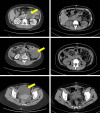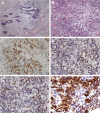Malignant mixed ovarian germ cell tumor composed of immature teratoma, yolk sac tumor and embryonal carcinoma harboring an EGFR mutation: a case report
- PMID: 30349318
- PMCID: PMC6190639
- DOI: 10.2147/OTT.S176854
Malignant mixed ovarian germ cell tumor composed of immature teratoma, yolk sac tumor and embryonal carcinoma harboring an EGFR mutation: a case report
Abstract
Malignant mixed ovarian germ cell tumors are very rare, accounting for ~5.3% of all malignant ovarian germ cell tumors (MOGCTs), with a very high degree of malignancy. The treatment of patients with persistent, refractory, or platinum-resistant MOGCT is not well defined. The objective of this case report was to analyze the importance of chemotherapy, salvage surgery and target therapy in the treatment of a patient with refractory OGCT after first-line chemotherapy failure. We reported a 34 year-old woman suffered from advanced refractory MOGCT after first-line chemotherapy, cytoreductive surgery, and a series of chemotherapy. The genetic test shows she is a carrier of EGFR: p.L858R mutation. Based on genetic testing result, she received icotinib which targeted for EGFR mutation, but the tumor progressed. After a secondary cytoreductive surgery, she exhibited a partial response and continued to receive chemotherapy. This suggests that salvage surgery may be considered for patients with persistent or refractory MOGCTs when no effective systemic treatment option is available. Targeted therapies based on gene sequencing may provide a new option; however, its efficacy and related resistance mechanisms still need to be verified by further study.
Keywords: EGFR mutation; mixed ovarian germ cell tumor; next-generation sequencing; salvage surgery; target therapy.
Conflict of interest statement
Disclosure The authors report no conflicts of interest in this work.
Figures








Similar articles
-
A Rare Case of Mixed Malignant Ovarian Germ Cell Tumor Composed of Immature Teratoma and Yolk Sac Tumor.Cureus. 2025 Apr 14;17(4):e82242. doi: 10.7759/cureus.82242. eCollection 2025 Apr. Cureus. 2025. PMID: 40370888 Free PMC article.
-
Current Strategy for the Treatment of Ovarian Germ Cell Tumors: Role of Extensive Surgery.Curr Treat Options Oncol. 2016 Aug;17(8):44. doi: 10.1007/s11864-016-0416-2. Curr Treat Options Oncol. 2016. PMID: 27357180 Review.
-
Germ cell tumors of the gonads: a selective review emphasizing problems in differential diagnosis, newly appreciated, and controversial issues.Mod Pathol. 2005 Feb;18 Suppl 2:S61-79. doi: 10.1038/modpathol.3800310. Mod Pathol. 2005. PMID: 15761467 Review.
-
[Clinical analysis of 15 cases of malignant ovarian germ cell tumors with lung metastasis].Zhonghua Fu Chan Ke Za Zhi. 2012 Jan;47(1):40-4. Zhonghua Fu Chan Ke Za Zhi. 2012. PMID: 22455692 Chinese.
-
High-dose chemotherapy and stem-cell rescue for salvage therapy for relapsed malignant mixed ovarian germ cell tumor: A case report.Gynecol Oncol Rep. 2017 Sep 29;22:72-74. doi: 10.1016/j.gore.2017.09.013. eCollection 2017 Nov. Gynecol Oncol Rep. 2017. PMID: 29062883 Free PMC article.
References
-
- Brown J, Friedlander M, Backes FJ, et al. Gynecologic Cancer Inter-group (GCIG) consensus review for ovarian germ cell tumors. Int J Gynecol Cancer. 2014;24(9 Suppl 3):S48–S54. - PubMed
-
- Smith HO, Berwick M, Verschraegen CF, et al. Incidence and survival rates for female malignant germ cell tumors. Obstet Gynecol. 2006;107(5):1075–1085. - PubMed
-
- Bidus MA, Elkas JC, Rose GS. Germ cell, stromal, and other ovarian tumors. In: DiSaia PJ, Creasman WT, Mannel RS, McMeekin DS, Mutch DG, editors. Clinical Gynecologic Oncology. New York: Elsevier; 2012. pp. 290.e7–313.e7.
-
- Gershenson DM. Management of ovarian germ cell tumors. J Clin Oncol. 2007;25(20):2938–2943. - PubMed
Publication types
LinkOut - more resources
Full Text Sources
Research Materials
Miscellaneous

